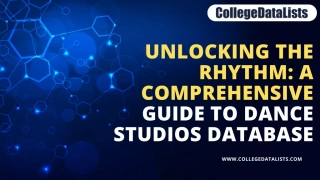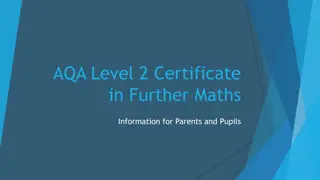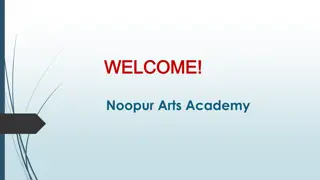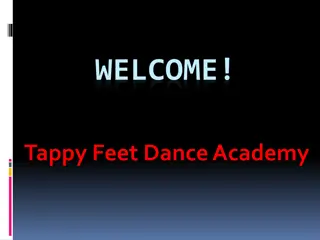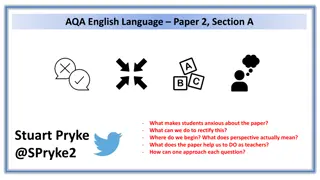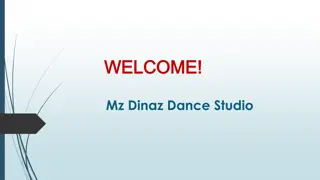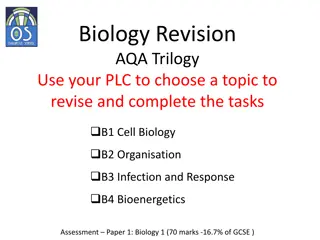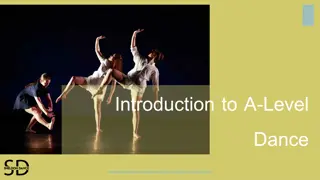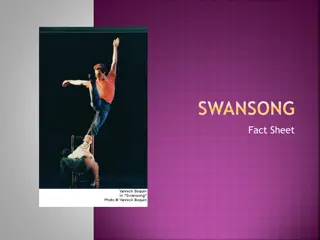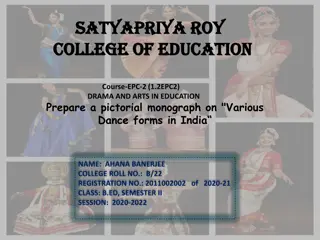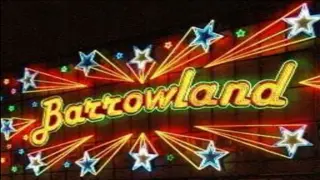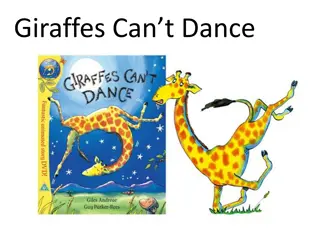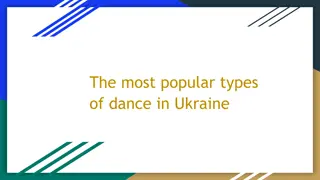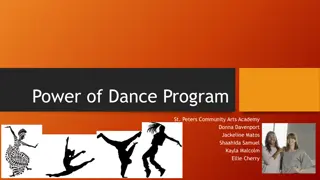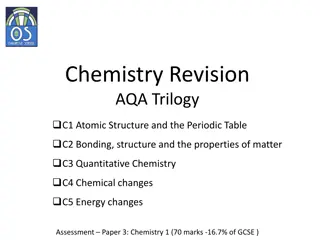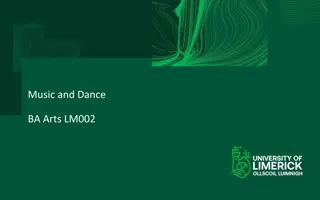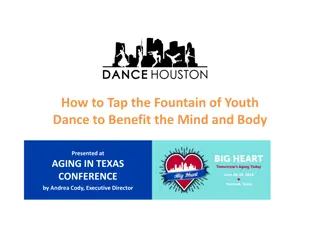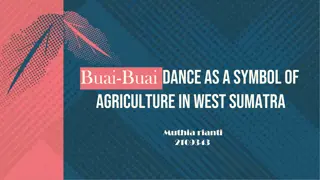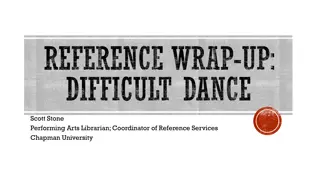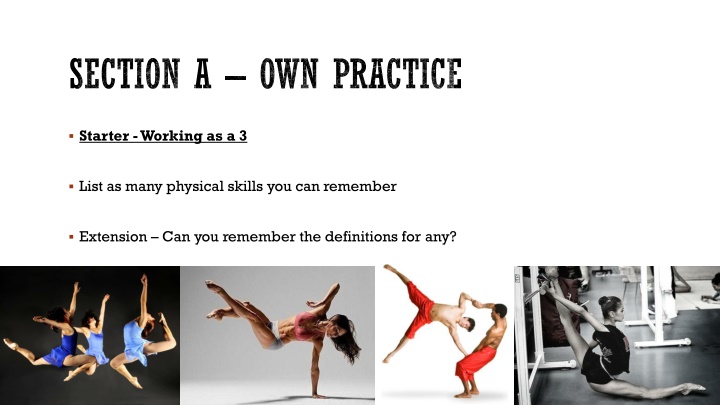
Enhancing Physical and Performance Skills in Dance Practice
Discover how to improve physical skills like agility, balance, and strength, and enhance performance skills such as focus, projection, and musicality in dance practice. Explore choreographic devices for creative expression.
Download Presentation

Please find below an Image/Link to download the presentation.
The content on the website is provided AS IS for your information and personal use only. It may not be sold, licensed, or shared on other websites without obtaining consent from the author. If you encounter any issues during the download, it is possible that the publisher has removed the file from their server.
You are allowed to download the files provided on this website for personal or commercial use, subject to the condition that they are used lawfully. All files are the property of their respective owners.
The content on the website is provided AS IS for your information and personal use only. It may not be sold, licensed, or shared on other websites without obtaining consent from the author.
E N D
Presentation Transcript
SECTION A OWN PRACTICE Starter -Working as a 3 List as many physical skills you can remember Extension Can you remember the definitions for any?
Task PHYSICAL SKILLS Can you identify 1 way you can improve each skill? Agility - The ability to move quickly with ease and efficiency. Alignment of the body - The optimum placement of and balance between joints in order to allow the body to move with ease and efficiency, removing unnecessary muscular tension and effort. Balance - The ability to maintain equilibrium over the base of support. Cardiovascular endurance - The capacity to sustain continuous moderate-level exercise. Flexibility - Static flexibility: the range of motion possible at a joint. Dynamic flexibility: the resistance of a joint to motion. Strength - The maximum force generated by a muscle against resistance in a single effort. Muscular endurance The ability to produce force against a particular resistance repeatedly. Neuromuscular coordination - The synchronous working of muscles during complex movements.
PERFORMANCE SKILLS Interpretative/performance skills (in order to communicate the dance idea(s) in a clear and considered manner) Do you know any performance skills?
Task PERFORMANCE SKILLS Can you explain how you used each skill in your solo/duet? Focus - The intensity and direction of the dancer's eyeline, for example to a specific point in space, to a fellow performer or to the audience. Projection - The engagement of dancer's whole self in the communication of the dance idea; a considered use of energy to attribute perceivable qualities to the movement content. Emphasis - The accents provided by the dancer at different moments throughout the dance. The accents may relate for example to energy, space and timing. Musicality - An interpretation of the music's structure, rhythm, mood and meaning by the dancer in performance. Timing - The use of time or counts when matching movements to sound and/or other dancers.
POSSIBLE QUESTIONS IN RELATION TO PERFORMANCE Sneaky tip you could make this up! You could be asked about how you used physical/performance skills in you solo or duet. You could be asked how you improved a skill, in relation to your solo or duet. For example With reference to the solo task you completed for component 1, explain how you developed the following interpretative skills in order to communicate the choreographic intention: musicality projection of the dance idea(s). [6 marks] Discuss - How would you answer this?
Task Have a go at writing this answer!
CHOREOGRAPHIC PROCESS Working as a 3 List as many choreographic devices you can remember. Extension What do the devices mean?
CHOREOGRAPHIC DEVICES Motif and motif development Motif - A movement phrase encapsulating an idea that is repeated and developed throughout the dance. Motif development - Ways in which a movement phrase can be varied. Variation Variation in movement, dynamics and spacing. Repetition - Performing the same action or phrase again. Contrast - Movements or shapes that have nothing in common. Highlights - Important moments of a dance Climax - The most significant moment of the dance. Transitions - Links between dance phrases or sections.
MOTIF AND DEVELOPMENT Add or change the action Change the size Change the level Using different body parts - instrumentation Alter the focus Change the direction, dimension or plane Alter floor pattern Reverse the order retrograde Change the dynamics Fragment the motif ie change only some parts Mix bits from different motifs Repeat the motif Task Can you give 3 examples of how you used choreographic devices in your solo?
STRUCTURE Task List the different types of structures you can use in a piece of choreography. Extension What do they mean? Binary Ternary Rondo Theme and variation Narrative Episodic
MIX AND MATCH ABCDE AB ADCFB ABA ABACADA A1A2A3 Binary Ternary Rondo Narrative Episodic Theme and variation
STRUCTURE Binary - An AB sectional structure/form. Section B provides the contrast to the opening section A. Ternary - An ABA structure/form which develops on from Binary by providing a return to and reiteration of the opening statement. This is thus cyclic in nature. Episodic - A series of sections presented by the choreographer. The sections can be selfcontained but when put together will illuminate the overarching theme of the choreographed work. Narrative - A sequential structure/form which allows the story to unfold. Rondo - An ABACADA structure/form. The repetition of 'A' provides the recurring theme whilst the other sections provide the variety and contrast. Theme and variation - An A, A1, A2, A3, etc. structure/form. A theme is stated at the outset of the dance and the subsequent sections are all variations of this theme. The initial theme is not necessarily re-stated in its original form.
AURAL SETTING The aural choices the choreographer decides upon in the creation of a work, ie music, the spoken word, sound effects, natural sound, found sound, the audible aspects of dancing, silence. consideration of tempo rhythm mood and atmosphere - This relationship aids in the communication of theme. The dancers may not be using the musical rhythm or phrasing but the aural setting is helping to evoke the mood and/or atmosphere. direct correlation - Dance and music work together, sharing the same time signature, tempo, phrasing and cadences. music visualisation - Dance which aims to clarify the music, using the structure and content as its base. The dance follows the rhythmic, melodic and harmonic lines in the music. mutual coexistence - Dance and music are created independently of each other but may share the same tempo, theme or directive. Disassociation - Dance and music are created independently of each other and when performed share only time and space. Narrative - The music and dance express an idea or tell a story. call and response - Similar to a conversation the music or dance 'calls', the other 'responds'.
POSSIBLE QUESTIONS IN RELATION TO CHOREOGRAPHY Sneaky tip you could make this up! You could be asked what structure you used in your choreography and why. You could be asked what choreographic devices you used and why. You could be asked about your choice of aural/physical setting and how it related to the choreographic idea. For example With reference to the solo choreographic task you completed for component 1, explain how the choice and use of the aural setting helped you to communicate your dance idea(s) effectively. [7 marks] Discuss - How would you answer this?
Task Have a go at writing this answer!

